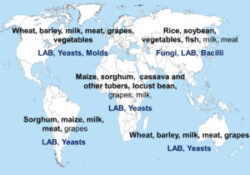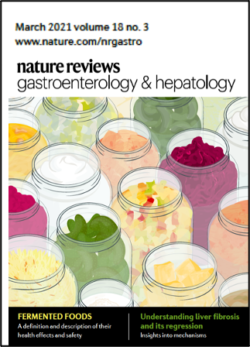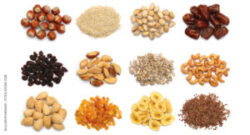
Beer sans alcohol
Non-alcohol beers have been around since the early 1900s. But it wasn’t until the 1920s and the implementation of Prohibition Laws in the U.S. that they became “popular”.
Despite their legal status and availability, they were never considered to be very good. This was because the ethanol was removed using thermal processes, like distillation or vacuum evaporation. These processes are damaging to beer flavor and quality, and although technologies have improved, they are less than ideal.
In the 1990s, membrane technologies (UF, dialysis, and RO) were adopted and remain widely used. Their advantage is that they are non-thermal and have less impact on beer quality. Nonetheless, there is evidence, as noted in this recent paper, that ethanol does play a role in flavor and aroma perception.
It should be noted that non- or low-alcohol beers are now more popular than ever before. This is largely because of laws and penalties (and social awareness) for vehicular driving-under-the-influence violations.
There is now current interest, as highlighted in this 2019 review, in making these beers based on the biology of the yeast. That is, are there strains that produce good flavor and palatability, but do not produce ethanol? Indeed, such strains do exist, and in general rely on their inability to ferment maltose, the main substrate in wort. This paper
describes many of these strains and their properties.
Image from: obersenorita.com

Global warming and Prof’s nightmare
Although we will not devote much time to this topic, climate change and global warming are already having serious effect on many fermented foods. Among the products perhaps most sensitive to a change of just a degree or two are wine grapes. Interestingly, there will be winners and losers. The reason why Cabernet Sauvignon grapes do well in Bordeaux, for example, is because the temperature, moisture, and sunlight hours are perfect for that particular grape cultivar in that specific region of France. If the climatic conditions are altered, then those grapes will not have the proper level of sweetness, acidity, or color necessary to make a good Bordeaux wine. The same considerations exist for other grapes grown throughout the rest of the world. Of course, as the temperature rises, colder regions (maybe even Nebraska) could become the “new” Napa Valley.
Then there are my other favorite fermented foods – coffee and chocolate. The growth of cocoa and coffee beans is also sensitive not only to temperature, sunlight, and moisture, but also elevation. Climate change will force farmers to move their plantations to more conducive elevations. This article points out that farmers in Central America and other coffee and cocoa-growing regions are poor and may not have the option to re-locate their farms. The authors also note another very important and often neglected collateral effect of climate change. Specifically, there are pests, both fungal and insects, of these products that may thrive and even spread as the temperature increases.
I can hardly imagine living in a world without wine, coffee, and chocolate. If I hear that the future of Parmesan cheese is also threatened, well, that would really be the end of Western Civilization.

Fermented foods, a global perspective
It’s fun to consider how our eating habits have changed over time. When I was in college, I was aware of only a few fermented foods – cheese, sour cream, pickles, bread, beer, and wine. I had never heard of kimchi, kefir, or miso, and perhaps no one in America had heard of kombucha. Your generation, in contrast, has grown up with many of these foods, so I assume you are more familiar with them than I was at your age.
Of course, in other cultures, these foods had a long culinary history. Indeed, there are just as many fermented foods manufactured and consumed in Asia, the Far East, and Africa as in so-called Western regions. That these foods are now being studied reflects the global interest in fermented foods, for their organoleptic as well as nutritional properties.
A few years ago, I was part of an expert panel consisting of scientists from Europe, Asia, and North America that reviewed the microbiological differences and similarities of fermented foods from around the world. Remarkably, the bacteria, yeasts, and molds responsible for fermentation are similar no matter the food or the location. This suggests that these microbes are very well adapted to particular food environments and also accounts for why even spontaneously fermented foods consistently turn out just fine.
The review was published in Comprehensive Reviews in Food Science and Food Safety. If you review the tables, you will see a lot of fermented foods listed that were definitely new to me. How many of these so-called non-Western foods do you recognize?

Fermented foods: 150 years of cutting edge science
I have been studying fermented foods for more than 40 years. Although I had a lot of company during that time, as a branch of microbiology, it was a rather small group. We usually published in applied microbiology journals and obtained grants from industry or commodity groups like the dairy board. The microbes we studied (mainly lactic acid bacteria) provided many scientific challenges, ranging from how they affect flavor and quality to how they defend themselves against viruses.
Flash-forward to 2021 and now interest in fermented foods has never been greater. I mentioned in class that the discovery of CRISPR in the yogurt organism, Streptococcus thermophilus, was published in 2007 in Science, one of the top journals in the world. Then in 2017, researchers at Harvard (yes, Harvard) published on the microbiota of cheese rinds in the journal Cell, another super high impact science journal.
Earlier in 2021, I was part of an international team of researchers who set out to define and describe properties of fermented foods. This led to a paper published in the medical journal, Nature Reviews Gastroenterology & Hepatology.
Finally, a few months later, researchers at Stanford conducted a human clinical trial to assess the health properties of fermented foods. This widely reported study was also published in Cell.
So why all the interest in fermented foods? There are plenty of reasons, which I noted in class. But the notion that fermented foods, especially those that contain live microbes, can enhance human health, is likely one of the most important reasons. But even when the fermentation microbes are inactivated by heat or removed physically (e.g., bread and wine), they can still transform foods and increase nutritional properties.
Importantly, there is still considerable interest among microbiologists to address quality issues in fermented foods, just has there has been since Pasteur first began to study beer spoilage 150 years ago. Modern molecular and chemical methods have greatly enhanced these efforts.
For all of these reasons, it’s a great field to study, whether you have been at it for 40 years or just getting started.

Really smart packaging
You are at the grocery store to purchase a package of fresh ground beef, or a bag of green beans, or some fresh salmon. Maybe you can gauge freshness by appearance or you perhaps you rely on the sell-by date. But you cannot smell or touch. So how do you know the product is still fresh and unspoiled? Wouldn’t it be great for consumers (and retailers) to know if a packaged product still retained freshness, even past the shelf-life.
The solution, studied for more than 20 years, are biosensors – devices or strips placed inside or incorporated into packages that provide visible freshness information. Also referred to more recently as smart packages, they now can be as simple as a barcode that you scan with your smart phone and within a second, you get a freshness report.
Still, the key to this technology is a chemical way to assess freshness or spoilage inside a package. Usually, they are based on headspace analysis of specific volatiles produced by spoilage bacteria. The most common spoilage targets include biogenic amines (as described here, here, and here), pH (here and here) and hydrogen sulfide
When that target molecule is produced by spoilage microbes, it reacts with receptors embedded in the package. There could be a color change, or as noted above, the latest generation systems convey the response via a barcode.
These systems are not only provide point of purchase freshness information, they continue to inform consumers after purchase, i.e., when the product is in their refrigerator. Thus, food waste can be minimized.
Image from www.foodnavigator.com

Stressed out
Quercetin is a natural polyphenolic compound found in plants. It has several beneficial health benefits, due, in part, to its antioxidant and anti-inflammatory activities. It may also have antimicrobial properties. In this 2020 paper published in Food Microbiology, the authors showed that quercetin damaged bacterial membranes (making them more permeable) and reduced biofilm formation (which we will discuss next week).
Interestingly, the research observed that quercetin repressed synthesis of stress response genes. What might be the significance of that finding?
Image from sarahs-world.blog/

Extending yogurt shelf-life, naturally
I noted in class that yogurt has a long shelf-life, usually many weeks longer than indicated on the labels “use-by” dates. After all, yogurt is made from milk that has received a high-temperature heat process. Most yogurts are made in a hygienic environment with minimal exposure. Importantly, the final product has a pH less than 4.5, sometimes even as low as pH 4.0.
Despite these conditions, spoilage can still occur, usually by acid-tolerant fungi, including both yeasts and molds. These microbes are either environmental contaminants or are introduced post-fermentation via fruits or other ingredients. Adding sorbic acid or other antimicrobials is generally not a viable option, because these products are usually marketed on their “natural” ingredients.
Although many lactic acid bacteria produce bacteriocins, these agents do not inhibit fungi. Nonetheless, there are other ways lactic acid bacteria can inhibit spoilage microbes. In this study, a team of scientists led by Chr. Hansens R & D group described a novel application of bioprotective cultures based on the principle of competitive exclusion. The latter occurs when organisms in the same environment or niche find themselves competing for limited availability of a carbon source or a particular nutrient. Whichever gets that nutrient first is the “winner”, effectively excluding the competitor.
In this case, the researchers discovered that two strains of Lactobacillus, L. paracasei and L. rhamnosus, had the unique ability to rapidly transport manganese. Indeed, so effective was their sequestration of manganese that milk quickly became depleted in this essential element. Importantly, fungi need manganese as a co-factor in enzymes essential for their growth.
Experiments revealed that adding these strains to milk inhibited yeast and mold, supporting the hypothesis. The researchers were also able to identify genes for manganese transport in these bacteria and measure expression via transcriptional profiling (i.e., mRNA for the relevant genes). Of the two transporters, one was an ABC system active at neutral pH, and the other was a proton-driven symporter active at acidic pH. The latter, encoded by the mntH gene, was considered more responsible for scavenging the manganese.
Because they knew which genes were involved, they were able to make deletion mutants, where the mntH gene was inactivated. As predicted, inhibition activity was eliminated. Likewise, if they used the manganese accumulating Lactobacillus strain but added back extra manganese, growth of the fungi was restored.
So successful was this research, Chr. Hansen now markets this as a bioprotective ingredient call “FRESHQ”, promoting it as a natural shelf-life extender.
Once again, another great example of physiology and genetics having a very applied outcome.

Cookies safe to eat
Most food preservation articles that get published in food microbiology journals refer to industrial processes. On occasion, I’ll come across a paper that addresses a very applied sort of problem. Such is this paper from the December 2021 issue of Food Microbiology.
As we noted in class, Salmonella can sometime persist in flour and other ingredients used in cookie recipes. The question they asked was whether normal baking conditions, like those used in one’s home kitchen, would be sufficient to inactivate Salmonella. They made two types of cookies, soft, cooked at a lower temperature for a longer time, and hard, cooked at a higher temperature for a shorter time. Both were effective.
We’ll start our discussion on the kinetics of heat inactivation on Wednesday, but this very similar to how milk is pasteurized, what we call High Temperature-Short Time (HTST) and Low Temperature-Long Time (LTLT). Indeed, it might seem counter intuitive, but we will learn that two different processes can be kinetically identical.

Low Moisture Foods – not always cut and dry.
Low moisture foods (LMF), as mentioned in class, have water activities too low to support growth of bacteria of public health concern. Indeed, according to the European ILSI, CODEX, and other authorities, the cutoff water activity for these foods is 0.85, below which pathogens cannot grow. These include a wide range of common foods like grains, flour, nuts, seeds, spices and infant formula.
A recent paper (October 2021) in the International Journal of Food Microbiology points out (as I also did in class) that although growth does not occur, neither does cell death. Thus, pathogens could still be present, leading to product recalls, but also, under a worse-case scenario, foodborne outbreaks.
Unfortunately, there have been plenty of the latter. Major cases included Salmonella in tahini, pistachios, dried coconut, and cereals, and several flour-borne outbreaks due to Salmonella and E. coli O26. Other recalls implicated eggs, cocoa, herbs and spices, and milk products.
But the main focus of this paper was on prevention. Specifically, they recommend steps that the LMF producers should adopt to prevent such occurrences. Most are focused on the production environment. Included are monitoring the equipment and production areas, with frequent cleaning ans well as routine testing based on indicator organisms.
I know it sounds like a broken record, but the bottom line is Hutkins’ Rule #1: Keep Out!
Image: foodqualityandsafety.com/

Psychrotrophic bacteria in foods, an old problem that never went away.
In class, I described a paper from the 1960s that discussed how low temperature storage of milk has selected for psychrotrophic spoilage bacteria. I also showed data on the increased expression of proteolytic enzymes by these bacteria when grown at low temperature.
Flash forward 60 years, and food microbiologists are still studying the physiology and properties of psychrotrophic bacteria. Three papers published in 2021 illustrate this point.
The first paper describes the very problem noted in class – Pseudomonas and other psychroptrophs produce proteolytic enzymes that spoil foods. What they show in this study, however, is that some of those enzymes are thermostable. Thus, if the microbes are not controlled pre-pasteurization, residual enzyme activity can even cause spoilage of sterile milk
This very applied study addresses a problem that I did not know existed. Specifically, they were interested in the microbial levels in absorbent pads used in chicken and meat packaging trays. These pads are intended to absorb the so-called “drip” or exudates that would otherwise accumulate in the trays. Psychrotrophic bacteria can grow in the liquid producing off-flavors and odors. Plus, consumers regard that liquid as a sign of spoilage. But enumerating the microbes in the pads is not so easy, since by definition, they are absorbent.. So the question was how to dislodge the microbes from the pads prior to plate counting. It turns out that stomaching (a technique used in Food Microbiology Laboratory) was not effective, nor was sonication. The best was blending. By the way, those pads are loaded with bacteria – more than 109 CFU/ml after 7 days in the fridge.
Finally, this third paper describes the genetic basis for expression of cold shock proteins. We will talk about this more in the coming lectures, but when psychotropic bacteria experience a drop in temperature, they respond by inducing expression of proteins and enzymes that enhance their ability to grow and manage in cold conditions. For example, they are better able to maintain fluid cell membranes and stabilize proteins and DNA. Research on cold shock proteins may eventually lead to strategies to inhibit psychrotrophs in food.
Not only do these studies provide a better basis for understanding properties and ecology of psychrotrophic bacteria, they also illustrate how important it is to read the literature, even literature that is 60 years old!
